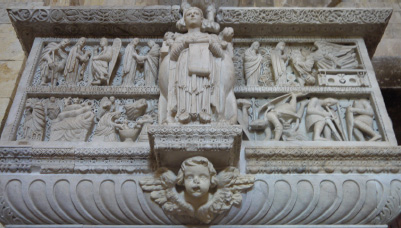![]()
CAGLIARI claims a precedence among the cities of Sardinia. The port of the Phoenicians and their Carthaginian heirs passed before 100 BC to Rome, and by AD 312 Cagliari was an episcopal see. With the Byzantine collapse in the West, the city – and indeed the rest of Sardinia – was subject to rival maritime powers. But in 1217 the Pisans established control, fortifying the ridge that remains the heart of the town. Cagliari fell to the Aragonese in 1326, and remained in Spanish control until 1720, when Sardinia was awarded to Vittorio Amadeo II of Savoy.
Although the tower of San Pancrazio of 1305 at the north-east angle survives, the Pisan walls have for the most part been replaced by successive Spanish and Piedmontese interventions, necessitated by the evolution of defensive warfare. At the higher, north, end of the ridge was the Citadel, and below this parallel streets were laid out. The Palazzo Reale, built for Carlo Emanuele III, and the cathedral dominate the central piazza that slopes steeply to the west. The Romanesque façade of the cathedral is a re-creation of 1933, but the side door to the right of this is an enchanting Gothic fantasy, as delicate as lace. The interior is memorable not least for its wealth of sculpture. At either side of the central door are two pulpits made up in the seventeenth century from that supplied by Guglielmo da Pisa in 1159–62 for the cathedral at Pisa, which was displaced by Giovanni Pisano’s masterpiece and despatched in 1312 to Cagliari. Of the sixteen narrative reliefs, the most memorable is perhaps that of the soldiers – medieval knights in full armour – by the tomb. The church is rich in baroque altars and funerary monuments. Of these the most striking, in the last chapel on the left, is that to Archbishop Bernardò dei Cariñeni (d. 1722), whose effigy, framed by curtains that have been drawn apart, is beneath the altar.

Cathedral: Guglielmo da Pisa, pulpit, 1159–62.
Cathedral: tomb of Bishop Bernardò dei Cariñeni.
Below the presbytery is the Santuario dei Martiri, three marble-faced chapels cut into the rock. The vault of the central Cappella della Madonna dei Martiri is enriched with 584 circular compartments, and the decoration of the sanctuary evidently reflects the taste of Archbishop Francesco d’Esquivel (d. 1624), whose monument dominates the vestibule. The smaller lateral chapels are dedicated to the martyrs of Cagliari, Saturninus and Luciferus. The marble facings incorporate fine Roman sarcophagi that had come to be associated with the saints. It is not difficult to understand why Prince Carlo Emanuele of Savoy, who died at Cagliari in 1799, was buried in one chapel and Queen Giuseppa Maria Luigia, who died in 1810, chose to be buried in the other. Their restrained neoclassical monuments are respectively by Antonio Cano and the Sardinian Andrea Galassi, who had studied under Canova to some effect.
On the site of the Citadel a museum complex was built in the 1980s. This already seems outmoded. The Museo Archeologico houses the main collection of prehistoric material from the nuraghi and other sites for which Sardinia is justly celebrated. Apart from some small figurines and metal statuettes that anticipate Giacometti, most of the material is of specialized interest. The most ambitious of the Roman sculptures is a statue of the younger Drusus, efficient but uninspired. The Pinacoteca Nazionale is higher up. Sardinia was a backwater where painting was concerned, but the sequence of polyptychs from the church of San Francesco di Stampace is unexpectedly impressive, not least for that of San Bernardino of 1455 by two Catalan masters, Rafael Tomas and Juan Figuera. The selection of the saint’s miracles includes one, of Bernardino floating across a river on his cloak, that Italian patrons seem to have considered too improbable to merit depiction.
There are other things to see at Cagliari, including the eroded and much restored Roman amphitheatre west of the ridge. But the tourist’s time may best be used by making for some of the neighbouring sites: Dolianova to the north-east, with the marvellous and well-preserved church of San Pantaleo, begun in the twelfth century and completed by 1299; or, to the north-west, the smaller Romanesque Santa Maria at Uta, beautifully set among trees; and its more modest neighbour, San Platano of about 1144 at Villaspeciosa, in which the front is enriched with spoil from earlier monuments. These, and their numerous counterparts throughout the island, suggest the strength of the religious revival of their period.
The Nuraghe Su Nuraxi near Barumini, one of the three most celebrated monuments of the kind, is roughly an hour north of Cagliari. The Sardinian term, nuraghe, which may preserve its prehistoric form, meaning a pile of stones with an internal cavity, does less than justice to the sophistication of the prehistoric fortresses for which the island is justly famous. The tower at the centre, originally eighteen and a half metres high, is datable to 1500–1300 BC, while the four adjoining ones were added in about 1300–1100 BC; the fortifications were extended in the early Iron Age (after 1100 BC), when many of the circular structures in the village outside the walls were built. Further structures were added in the Iron Age (800–500 BC). Visitor numbers mean that guided tours are the rule; and the circuit of the tholos-crowned internal chambers and the narrow internal passages is not, perhaps, for those who suffer from claustrophobia, but tells us something of the cramped conditions in which the builders of nuraghi expected to protect themselves.
Two miles to the west is the parish church of San Pietro in the small town of Tuili. The retable of 1500 by the Master of Castelsardo is perhaps the masterpiece of Sardinian Renaissance painting, fascinating for what it tells of complementary strands of Italian, Spanish and northern influence. The anonymous painter’s radiant colour is a wonderful contrast to the dark passages of the Nuraghe Su Nuraxi.